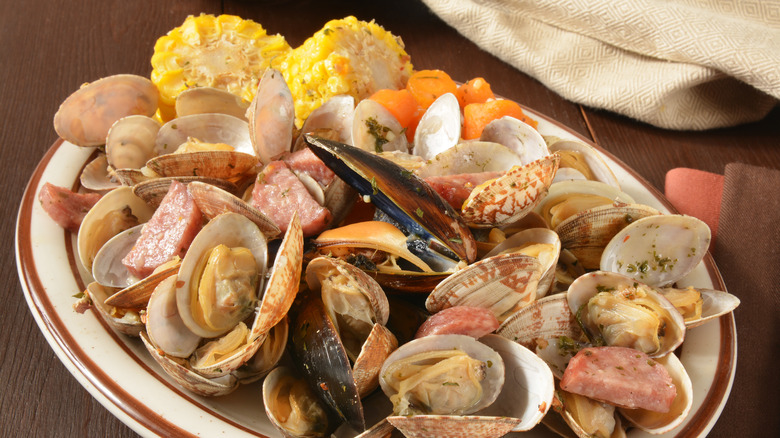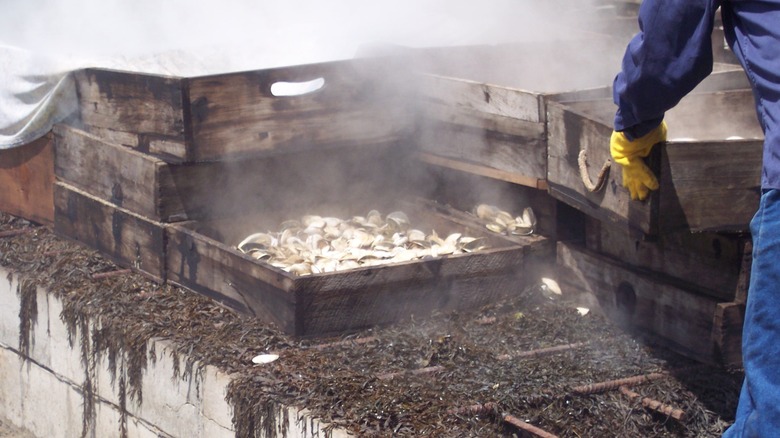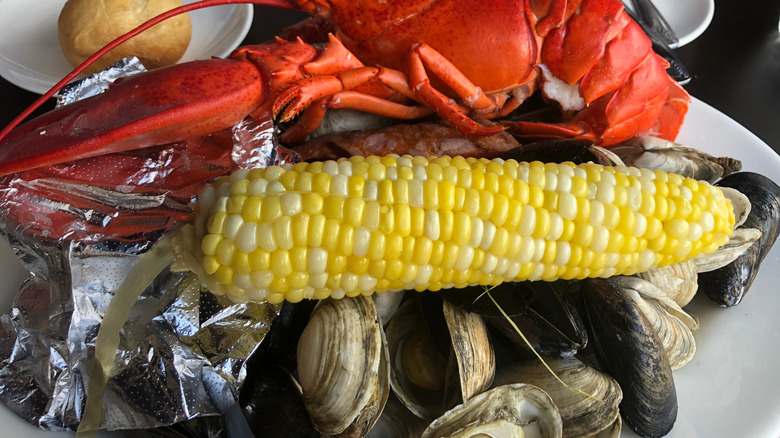What Makes A New England-Style Clambake Unique?
All along the Atlantic coast and stretching into the Gulf of Mexico, beachy summer days followed by seafood bake and boil evenings are a perfect pairing. These popular feasts bring the community together; perfect for both intimate family gatherings and grand seaside celebrations. Each region imparts its local shellfish, seafood, and style, to the bake or boil.
LobsterGram reports that Southern seafood boils use large cooking pots filled with salted water to slowly boil ingredients into a savory stew. Gulf coast preparations start with shrimp, soft shell crabs, crawfish, andouille sausage, ham, potatoes or boiled rice, and generous smatterings of pungent Cajun and Creole spice, hot pepper sauce, and lemons. While southern coastal states opt for boils and stews using local shrimp, shellfish, potatoes, corn, ham, mild sausages, aromatic herbs, and scant spices. These creations may be prepared on the beach in a fire pit or in the kitchen.
It's all about the steam in the Mid-Atlantic states. In fact, rather than boiling the shellfish, local blue crab, clams, and oysters, are steamed in baskets hung in large pots over a few inches of boiling water just until the bivalves pop open and the crabs change color. The seafood is seasoned with Old Bay and served with lemon and butter alongside corn on the cob and coleslaw.
Cooking styles and the name of the feast change once again as you arrive in the northern states of New England. Here's what makes a New England-style clambake stand apart from the others.
New England clambakes are primitive
Seafood bakes were popular amongst the Atlantic coast-based Wampanoag, Wabanaki, and other Northeast indigenous peoples before Europeans encroached upon their lands, reports New England Today. Early New England settlers adopted the tradition of cooking their bounty on the beach. By the late 1700s, the Old Colony Club in Plymouth, Massachusetts, featured massive seafood bakes to celebrate what they called Forefather's Day. Now called clambakes, these festive feasts became a cornerstone of leisure-class coastal dining.
New England clambakes teem with clams freshly dug from the murky sand, and mussels and oysters, when they are in season. Rather than boiling or steaming the harvest in enormous metal pots, New Englanders take a primitive approach to their seafood bakes. Early in the day, substantial pits are dug in the deep sand. They are partially filled with firewood with large rocks distributed over top. A fire is set to preheat the rocks.
Once the wood is burned to coals, a layer of wet seaweed is arranged upon the hot rocks to serve as a platform and to encourage steam and smoke, which adds a delicious charred flavor. Cleaned bivalves are arranged on the seaweed. Potatoes, ears of corn, sausages, and sometimes hotdogs (if you're a Mainer) are added along with another layer of seaweed. When in season, the clambake is topped with a few just-caught lobsters. Per New England Today, the pit is covered with a wet tarp to contain the steam and encourage cooking.
Serving a clambake feast
According to New England Today, it takes about ninety minutes to cook the beachy clambake for optimal results. Be sure to slowly unwrap the tarp and seaweed. The regale is served with ample drawn butter, bread, and beer or wine, usually on paper plates with bibs and stacks of napkins for sopping up the juices and wiping off the steam.
Can't make it to New England to quench your clambake craving?
No matter where you are, you can make a delicious clambake at home without donning clamdiggers and getting muddy hunting for dinner in the surf. Simply Recipes reveals that at-home clambakes are an easy way to enjoy the tastes of a New England summer. Start by cleaning the clams and mussels. Then prep your potatoes and ears of corn. Place the potatoes in a large pot with a few inches of boiling water and simmer for ten minutes. Top the potatoes with the corn, clams, mussels, sausage, hotdogs, and lobster tails or claws. Cover the pot and steam until the clams and mussels open and the lobster turns bright red. Old Bay enhances the succulent flavors of the shellfish and the vegetables, and butter and lemon are essentials for any clambake or seafood boil.


